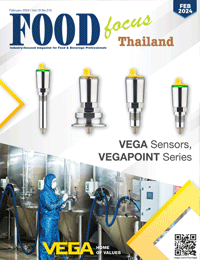บรรจุภัณฑ์ทางเลือกเพื่อความยั่งยืนสำหรับผลิตภัณฑ์เนื้อสัตว์ เรื่องเล่าจากงาน Food Focus Thailand Roadmap: Meat and Poultry Edition 2023 Sustainable and Alternative Packaging for Meat Products The Conclusion from Food Focus Thailand Roadmap: Meat and Poul
1663 Views |

By. ดร. ศิริวรรณ ตั้งแสงประทีป
Siriwan Tungsangprateep, Ph.D.
Senior Researcher
Thai Packaging Centre
Thailand Institute of Scientific and Technological Research
siriwan_t@tistr.or.th
วัสดุและบรรจุภัณฑ์ที่เป็นมิตรกับสิ่งแวดล้อมสำหรับผลิตภัณฑ์เนื้อสัตว์
บรรจุภัณฑ์สำหรับผลิตภัณฑ์เนื้อสัตว์โดยเฉพาะเนื้อสดมีปัจจัยสำคัญที่จำเป็นต้องคำนึงถึง คือ การเปลี่ยนสีของเนื้อตามปฏิกิริยาออกซิเดชัน (Oxidation) ซึ่งเกี่ยวข้องกับการมีอยู่ของก๊าซออกซิเจนที่จะต้องทำความเข้าใจถึงกลไกการเปลี่ยนแปลงดังกล่าว รวมทั้งต้องควบคุมปริมาณออกซิเจนที่อยู่ในบรรจุภัณฑ์ จึงมีการเลือกใช้คุณสมบัติของบรรจุภัณฑ์ที่มีตัวสกัดกั้นสูงเพื่อวัตถุประสงค์ดังกล่าว และช่วยรักษาความสด พร้อมทั้งป้องกันการหืนได้อีกด้วย นอกจากนี้พลาสติกยังเป็นวัสดุเพียงชนิดเดียวที่สามารถมองเห็นสินค้าภายในได้ โดยเฉพาะผลิตภัณฑ์ประเภทเนื้อสดที่ผู้บริโภคส่วนใหญ่มักจะไม่เลือกซื้อหากมองไม่เห็นสินค้าด้านใน อย่างไรก็ตามด้วยเทคโนโลยีด้านบรรจุภัณฑ์จึงได้มีการพัฒนาโครงสร้างของบรรจุภัณฑ์พลาสติกเพื่อให้สามารถรักษาคุณภาพและความสดใหม่โดยเฉพาะสีของเนื้อสัตว์มาได้ระยะหนึ่งแล้ว ดังนั้น แนวทางการพัฒนาบรรจุภัณฑ์ในช่วงเวลานี้จึงเป็นการพัฒนาหรือเลือกใช้วัสดุบรรจุภัณฑ์ที่คำนึงถึงความเป็นมิตรกับสิ่งแวดล้อมมากขึ้น ตัวอย่างเช่น พลาสติกจากวัสดุฐานชีวภาพที่สามารถผลิตขึ้นใหม่ได้ในชั่วอายุคนและสามารถย่อยสลายได้ทางชีวภาพ เช่น พอลิแลคติกแอซิด (Polylactic Acid; PLA) ซึ่งเป็นเทอร์โมพลาสติกจากอ้อย ข้าวโพด หรือแป้งมันสำปะหลัง พลาสติกย่อยสลายได้ทางชีวภาพในระบบฝังกลบ (Land Fill Biodegradable Plastic) และพลาสติกรีไซเคิลจากพลาสติกที่ใช้แล้ว เช่น รีไซเคิลพอลิเอทิลีนเทเรฟทาเลต (Recycled Polyethylene Terephthalate; rPET) ซึ่งตอบสนองต่อระบบเศรษฐกิจหมุนเวียน (Circular Economy)
Ecological Materials and Packaging for Meat Products
Packaging for meat products, especially fresh meat, must be designed considering several important factors. For instance, oxidation, associated with the presence of oxygen, can cause color change in meat and requires a good understanding of the mechanisms involved. The levels of oxygen in packaging must be optimized. Hence, high-barrier packaging materials must ensure maximum protection, freshness maintenance, and rancidity prevention. Plastic is the only transparent material that allows consumers to view the packaged product from the outside. Such an advantage makes plastic ideal for fresh meat because consumers tend to avoid making a purchase altogether if they cannot see the meat within. Thanks to modern packaging technologies, plastic packaging structures have been enhanced to preserve meat quality, freshness, and color more efficiently. Since these initiatives have been going on for quite some time, the current packaging development efforts usually focus on aspects related to environmental sustainability, such as renewable, bio-based, and biodegradable plastics. These include, for example, polylactic acid (PLA), which is a thermoplastic produced from sugarcane, maize, or tapioca starch, landfill-biodegradable plastic, and recycled plastic, such as recycle polyethylene terephthalate (rPET). These materials are compatible with the circular economy.






